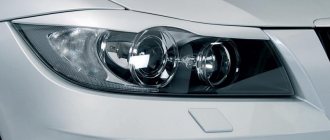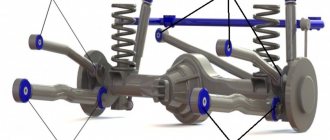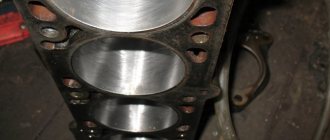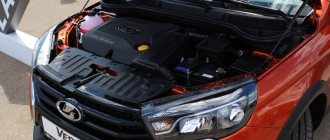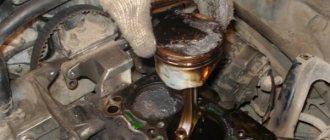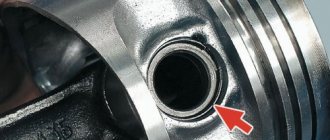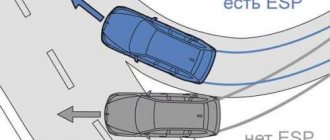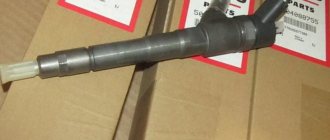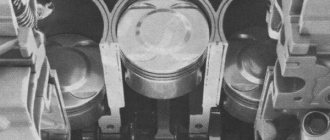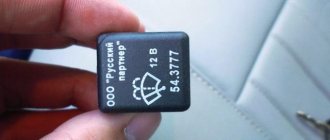Many drivers are familiar with the principles of operation of an internal combustion engine. It contains many components that determine the normal functioning of all systems of the unit. For example, such seemingly insignificant parts as piston rings perform a fairly important function in the operation of the engine.
If these parts are worn out, this immediately affects the performance of the engine, and the consumption of fuel and engine oil increases sharply. But in order to install new rings yourself, you need to understand their types and features. If, unknowingly, you put a kit of the wrong diameter on the piston or install the parts in the wrong order, this may result in the need for a major engine overhaul.
PURPOSE OF PISTON RINGS
We will not go into detail about the principles of operation of an internal combustion engine. We will only touch on the issue of connecting the pistons and the engine cylinder. As you know, it is airtight. However, the pistons easily slide along the inner rings of the cylinder, preventing gases from the above-piston space from penetrating into the gap between the two surfaces into the crankcase of the unit.
However, some gas leakage still occurs even on a fully functional engine, but with high-quality rings it is an acceptable norm and cannot in any way affect the operation of the unit. When these piston parts wear out significantly, the amount of gases entering the crankcase increases.
But there is another purpose for performing a number of such functions:
- hermetic connection between the surfaces of the pistons and the cylinder walls;
- ensuring the required amount of oil on the cylinder walls and preventing it from entering the combustion chamber;
- The rings conduct heat from the pistons to the cylinder walls, which prevents overheating and corrosion.
It is not difficult to guess that the pistons perform their task under extremely aggressive conditions. On the one hand, these are extreme temperatures that arise during the operation of the unit. On the other hand, there are conditions of oil starvation in the upper part of the piston. These problems are solved by selecting materials for all types of rings and their different shapes.
Important! High-quality piston rings must be narrow enough. Experts say that the thinner the ring, the more effectively it will prevent piston vibrations at high engine speeds. In addition, they cope better with friction during the piston stroke.
But if the engine has average power, then regular, cheaper wide rings will be sufficient.
What are engine rings made of?
One of the first effective materials used for piston rings was ductile iron. It is combined with the cast iron used in engine blocks, and its porous structure allows it to retain oil, reducing wear. A derivative of ductile cast iron known as ductile cast iron is also widely used. It has most of the qualities of cast iron, and in addition, it can be elastically deformed, which makes it easier to install the rings.
Stainless steel piston rings are an improvement over chrome plated cast iron rings. Essentially, stainless steel is a material that contains large amounts of chromium. And there is nothing strange in the fact that such rings have properties similar to those of chrome-plated rings. Stainless steel also has the ability to withstand high temperatures superior to chrome-plated cast iron.
In an attempt to increase the service life of rings and ensure rapid break-in, molybdenum rings were created. Such a ring is usually a ring with a cast iron base with a molybdenum surface coating. Molybdenum shares many of the anti-wear properties of chromium, and in some cases it can be even more resistant to wear. Over time, molybdenum rings have become a staple in engines because they are durable, relatively easy to break in, and more reliable.
SELECTION OF SPARE PARTS
When performing engine overhauls, it is necessary to select the correct piston rings, since an incorrect selection will either lead to a lack of necessary compression or to jamming of the pistons in the cylinders with subsequent destruction of the rings and the formation of numerous scuffs on the pistons and cylinder walls. Using the VAZ-2111 engine as an example, let’s look at how to choose the right parts.
There is a table of repair sizes for pistons and rings, with the help of which it is quite easy to select the appropriate diameter of the parts. The base diameter of the VAZ-2111 engine cylinders is 82 mm, the repair pistons have an increased diameter: by 0.4 mm for the first repair and by 0.8 mm for the second. Rings for repair sizes also have an increased diameter and are marked accordingly.
In general terms, the process of overhauling a VAZ-2111 engine looks like this: the cylinders are bored to the first repair size, while a small allowance is left for honing. Then the old pistons are replaced with new ones of increased diameter, and piston rings of the first repair size are mounted on them.
A table of repair sizes exists for all engines, and choosing the right diameter is not difficult for any engine, be it a VAZ or Subaru engine.
| Engine model (VAZ) | Ring size (mm) | ||
| normal | 1st repair | 2nd repair | |
| 2101, 2103, 2108, 21081, 1111 | 76 | 76,4 | 76,8 |
| 21011, 2105, 2106, 2121 | 79 | 79,4 | 79,8 |
| 21082, 21213, 2110, 11113 | 82 | 82,4 | 82,8 |
WHICH RINGS ARE BETTER
The question of which piston rings are best to purchase for replacement haunts many car owners. With the variety available, it is not easy to make a choice. You can answer this: if the purpose of the replacement is to restore the normal performance of the engine, the standard ones are quite sufficient, but if the owner wants to improve the performance of the engine, it is better to pay attention to more “sophisticated” products, for example, chrome-plated or molybdenum.
WHY IS THERMAL CLEARANCE IN PISTON RINGS NEEDED?
It is known that in the process of moving the piston, it perceives enormous pressure. This pressure is transferred to the crankshaft. It is the presence of a gap in the structure that allows this pressure to be transmitted as much as possible and its value fully utilized.
In addition, the thermal gap ensures minimal contact between the surfaces of the piston and cylinder. Otherwise, these parts would be subject to increased wear. Another equally important function is to provide surfaces with an optimal amount of oil lubricant. Oil penetrates into the gaps, but does not enter the combustion chamber.
We recommend: Intercooler - what is it in a car
Important! The required thermal gap must be within 0.6-0.3 mm. In addition, care should be taken to ensure the permissible lateral clearance between the ring and the piston wall. The norm is a distance of 0.08-0.04.
It is the gaps that ensure effective heat removal from the surfaces of parts. In this case, they are used to compensate for excess temperature effects. If the above parameters are not provided, the engine will not produce the expected characteristics.
TYPES OF PISTON RINGS
Depending on their purpose, piston rings are divided into the following types:
- compression;
- oil scraper
Previously, a large number of rings were installed on the pistons of old engines with low power ratings. Now, most car models use three rings. They are installed in the following order.
- Upper compression. It has a molybdenum anti-wear insert.
- The second is compression.
- Oil scraper.
The oil scraper ring consists of three parts. These are the upper and lower oil scraper plates, and between them there is a tangential expander.
This is exactly what a set of piston rings looks like for modern gasoline engines. Depending on the year of manufacture of the vehicle, other sets of parts may be used.
Compression piston rings are designed to seal the surfaces of the piston and cylinder, they also prevent the penetration of gas into the combustion chamber and provide heat removal.
These types of parts differ from each other in one way or another. It is also worth considering the fact that various manufacturers can change the design and material of the rings, thus increasing their strength and improving the performance of the unit.
Second compression and oil rings of the engine
The main purpose of the second compression ring is to provide an additional seal after the upper oil control ring. Because of this, the second ring usually only "monitors" the gases that pass by the upper ring, and the pressure and temperature are different from the values for the upper compression ring. Accordingly, the materials and design of the second ring are less critical.
However, the second ring has an important additional function: it assists the oil scraper ring, acting as a “scraper”, preventing excess oil from entering the combustion chamber and causing detonation.
Some second compression rings are specifically made to be beveled to aid the operation of the oil control ring, with the bevel being least at the top edge of the ring. It tends to move on top of the oil as it moves up in the cylinder and will remove oil as it moves down. If oil removal is a problem, this type of ring will force the oil out, although a second flat face ring along with a "normal" force oil scraper ring is all that is needed.
The second compression ring without gap is a new design. The term “without clearance” used here is somewhat incorrect, since it is generally impossible to make a ring completely without clearance - it will be impossible to install it on the piston, and the ring will be unadjustable even with the smallest deviations in the shape of the cylinder bore from the circle. Ignoring this, the ring can be made without any visible gap for gases to flow past the ring. By using these rings, the engine will break in faster during the break-in process and will produce slightly more power when tested on the bench.
The need for backlash-free rings depends to varying degrees on how other rings perform. While the top compression ring provides a good seal, a backlash-free second compression ring is less important. However, in reality this is not the case and a second clearance-free compression ring may be a viable option in getting more power to the crankshaft.
Oil scraper rings are very important for the functioning of engines, especially when using low octane fuel. Engine oil that remains in the combustion chamber will reduce the octane number of the fuel, which can lead to detonation. It can also contaminate the combustion chambers and piston heads, which will definitely cause a decrease in engine power.
The rings are put on the piston in a specially made groove in it. The rings themselves are an open circle, which allows them to be put on and removed from the piston without breaking them.
Almost all engines have 2 types of piston rings, depending on the function they perform:
- compression rings are inserted into special grooves in the upper part of the piston. There are usually from 3 to 7 of them on one piston. These rings primarily serve as a seal between the cylinder walls and the piston and prevent the fuel/air mixture during the combustion stroke from entering the crankcase. In addition, another role of piston compression rings is to transfer heat from the piston to the cylinder liner, as well as absorb some of the piston vibrations due to lateral thrust.
- Oil rings are slightly different piston rings that are located below the compression rings. Oil scraper rings ensure perfect lubrication of the cylinder wall by removing most of the oil from the liner surface as the piston moves down. This is done in order to minimize the entry of oil into the combustion chamber and, as a result, its consumption.
The piston rings are very elastic. They independently regulate their diameter, pressing against the cylinder and at the same time remaining in their grooves. They also minimize the contact area between the piston and cylinder and thus significantly reduce friction, which would otherwise lead to piston wear and reduced engine efficiency due to the high resistance created by this friction.
Why are piston rings needed?
Piston rings allow the use of very light materials, such as aluminum, in pistons, because resistance to friction is no longer among the requirements for piston material, since it is the ring that fulfills it.
Just imagine if your car engine had no rings, and the piston would rub directly against the cylinder walls. What would happen then? Well, firstly, the piston would have to be the same size as the cylinders. But here we would have a big problem: when heated, the piston expands in diameter, and thus it could get stuck in the cylinder, which would lead to expensive repairs. Secondly, such a piston would very quickly cause more and more loss of compression due to rapid wear. This is why piston rings play such an important role.
The process of installing the ring on the piston
To summarize, we note that the rings in the engine perform 4 main functions:
- Compression . Piston rings keep the combustion chamber isolated from the crankcase, allowing for more efficient compression of the fuel in the chamber. Those. gaseous combustion products arising at the moment of ignition do not pass through the targets between the piston and the cylinder, because the ring protects against the occurrence of such gaps.
- Saving oil consumption . Oil scraper rings remove some of the oil from the cylinder walls while the engine is running, due to which the compression rings are perfectly lubricated, and at the same time, excess oil does not enter the combustion chambers.
- Heat transfer . Piston rings transfer heat from the piston to the cylinder. When the fuel-air mixture ignites in the combustion chambers, the temperature inside it reaches approximately 300 °C. If heat accumulates inside the piston, the engine may be damaged.
- Dampening horizontal vibrations of the piston . Pressing tightly against the cylinder walls, the piston rings prevent the piston from “walking” in horizontal directions, which prevents wear on the piston group of the engine.
Purpose, types, features
Piston device
We recommend: Fan windshield washer nozzles: how they work
These CPG elements have a number of important functions:
- Ensures the tightness of the combustion chamber.
- They regulate the amount of lubricant used to lubricate the cylinder walls, and also prevent it from entering the space above the piston.
- Heat is removed from the piston to the cylinder.
The functioning of piston rings takes place under rather difficult conditions - high temperature exposure, significant mechanical loads arising not only from constant exposure to gases, but also from increased friction due to a lack of lubricant in the area of the piston bottom.
One ring would not cope with the tasks, so several elements are installed on the piston, each of which performs specific functions. All piston rings are divided into two types:
- compression (designed to ensure tightness);
- oil scraper (adjust the amount of lubricant in the CPG).
The total quantity may vary and depends on the design features of the power plant. The most widespread is the three-ring arrangement (2 - compression, 1 - oil scraper). But there are engines in which their number can reach 7 pieces. For example, on two-stroke engines only two compression valves are installed, and the oil scraper is not used.
All rings used are of the open type. That is, they are not solid (it would simply be impossible to install it in the piston groove), and there is a cutout in it, which, by the way, also plays an important role.
In the expanded state, the rings are made in the shape of an oval, and the distance between the ends is significant. This makes it possible to easily put it on the piston and install it in a special groove in it. When seated in a cylinder, it takes on a regular round shape, which ensures a fit around the entire circumference, while the cutout (lock) is reduced, and this gap is only 0.15-0.5 mm. This gap is thermal, and its task is to compensate for dimensions as a result of thermal expansion.
Since there is a gap, gases can pass through it into the sub-piston space. To eliminate this factor, two compression rings are installed. They create a so-called labyrinth-type seal, for which the lock of the first ring is turned 180 degrees. regarding the second. But even this solution does not ensure complete sealing of the above-piston space and some of the gases penetrate into the crankcase.
Note that the installation of an additional third compression ring, although it allows to reduce leaks, but at the same time the friction force in the CPG increases greatly, so this solution is impractical.
Compression rings
The main load falls on the first compression ring, located closest to the piston bottom. Its main task is to ensure the tightness of the combustion chamber. It is the one that experiences the most high-temperature exposure and gas pressure, and all this in conditions of a lack of lubricant. In order to minimize friction between the wall and the ring, the latter’s working surface is made rounded. Also, a molybdenum or chromium insert sprayed onto the surface can reduce the wear of the upper ring when operating under difficult conditions, but it itself is made of elastic high-strength cast iron, but sometimes steel is also used.
Video: 2.0 ICE Theory: Error in installing the oil scraper piston ring
It is noteworthy that the working gases take part in creating the tightness of the combustion chamber. For this purpose, the height of the ring is slightly less than the height of the groove. Through the gap formed, gases penetrate into the groove and begin to put pressure on the inner surface of the ring, further pressing it against the wall.
Some manufacturers produce so-called “one-piece” compression rings. In fact, it consists of two flat rings, which, after being seated on the piston, turn 180° relative to each other using locks. In essence, this design makes it possible to complicate the labyrinth seal, thereby reducing the amount of gases passed through.
The second compression ring serves two purposes. Firstly, it is an element of the labyrinth seal and prevents the penetration of gases that have broken through the upper ring into the sub-piston cavity. And secondly, it takes part in adjusting the amount of lubricant on the cylinder walls. This element has a specific working surface shape (conical or L-shaped). This surface plays the role of a scraper, removing excess lubricant from the walls and discharging it to the oil scraper ring. That's why it is also called scraper.
Since it takes significantly less load than the first one, high-strength spraying is not used in its design; it is made entirely of ductile cast iron.
Oil scraper rings
The task of oil scraper rings is to adjust the thickness of the oil film on the cylinder walls, namely adjustment, and not complete removal of the lubricant. If there is not enough oil, the friction force will be increased, which will lead to rapid wear of the rings, as well as the possible appearance of scoring on the cylinder walls. A large amount of it, when burned in the combustion chamber, will settle in the form of soot on all surfaces inside it.
Is it possible to avoid repairs?
It may seem that everything is very depressing - climbing inside the engine to replace the rings is long, difficult and expensive. However, there is a way out. Today, the question of whether it is possible to avoid replacing rings in cases of coking is answered by auto chemical goods. Many manufacturers produce special products that are designed to solve these problems. The remedies are fast-acting. They are able to restore mobility to the rings, clean cylinders, pistons, combustion chambers, equalize compression, and reduce the level of harmful emissions.
All of them are divided into two groups. The first is fuel additives that provide so-called “soft” decarbonization - a very simple method that is usually combined with changing the oil and oil filter. The second is a means for the “hard” method, which is recommended for use by advanced motorists or in service stations.
Practice shows that the use of these products in case of engine overheating, “smoking”, or increased engine oil consumption, in the vast majority of cases solves the problem and eliminates expensive repairs.
The conclusion is simple. If a problem appears, then there is no need to immediately rush to replace the rings or try to repair the engine, because you can try to eliminate it using chemical “decarbonization” or use the SUPROTEC tribological repair compound.
Basic faults
Since these CPG elements are in constant contact with the cylinder wall, their main malfunction is the wear of the working surfaces. The service life of these elements largely depends on the material of manufacture and operating conditions, and it can vary from 150 thousand to 1 million km.
But failure to comply with operating rules can significantly reduce their service life. The resource can be affected by:
- Untimely replacement of lubricant in the power plant.
- Use of low quality fuel.
- Frequent use of the car in traffic jams or short trips.
- Creating excessively large loads on the power plant.
- Motor overheating.
The main signs of severe wear of the piston rings are a strong drop in compression, as a result of which the power and dynamic performance of the car decrease and fuel consumption increases, as well as a significant increase in lubricant consumption.
What are piston rings made of?
The materials currently used are high-strength cast iron and stainless steel. Since modern engines have become smaller and more powerful, and accordingly the load on them has increased many times, there is a need to use innovative materials. The leader among materials is molybdenum, characterized by anti-friction properties and increased service life. By the way, piston skirts are treated with a similar composition.
Decarbonization of piston rings
If the engine starts to smoke, there is a possibility that there are rings stuck in the piston grooves. Nowadays, there are many different modern means for decarbonizing piston rings, and many drivers use them to restore engine performance. Among the most popular compositions are:
- Nitrox Power;
- LAVR ML-202;
- Titanium;
- LIQUI MOLY;
- WYNN'S.
Motorists believe that if the engine starts smoking, you need to use a decarbonizer, and the engine will work as before, without oil consumption and without smoke. Indeed, sometimes these remedies help, but only in cases where the motor has stood motionless for a long time (for example, after winter), and moisture has accumulated in it. If the car is subject to long-term preservation (put in a garage for winter storage), you should remove the spark plugs and pour oil into the cylinders, and plug the spark plug holes with plugs. With such prevention, the spark plugs will not become damp and rust will not accumulate on the sleeves.
But if, after all, a forgetful car owner has not taken preventive measures, you can use a decarbonizer. We get rid of rust in cylinders as follows:
- pull off high-voltage wires;
- unscrew all spark plugs;
- rotate the crankshaft so that all pistons are in the middle position;
- pour 45 ml of liquid into each cylinder, install spark plugs;
- leave the cylinders to “soak” for 6-7 hours;
- why do we turn out the spark plugs, turn the starter a few revolutions so that all the dirt flies out of the engine;
- We put the removed parts back in place and start the engine. At first it may smoke a lot, but then the smoke will go away.
Car owners should remember that decarbonization is not a panacea for all ills, and if the piston rings are worn out, then only replacing them will help.
Replacing rings and valve stem seals
Replacing rings
If you have determined for sure that engine repair is required, then you should proceed with the next steps.
You will need a lot of tools and wrenches to get the job done. Before disassembling the car, drive straight to the pit. You will do a lot of work from the position under the car.
Disassembly sequence:
- Open the hood.
- Remove the wires going to the cylinder head.
- Remove the cylinder head cover.
- Then remove the cylinder head itself.
- Drain the oil from the bottom of the engine (under the car).
- Unscrew and remove the pan.
- Then remove the connecting rod caps.
Unscrew the nuts of the connecting rod bolts (1) and remove the connecting rod cover (2)
Next you have to remove the old rings from the pistons, after which the pistons can be placed in diesel fuel for a day. When the carbon deposits are almost cleared, you should prepare the ring seats. They can be cleaned with a gypsy needle.
After cleaning the parts from carbon deposits, it’s time to install the rings. This must be done carefully to avoid breaking them. Oil scrapers are installed immediately, then compression ones.
Piston ring installation diagram
For more information about the process of replacing piston rings, watch these videos:
After replacing the rings, proceed in the reverse order of disassembly. Once the pan is screwed in, move to the top of the engine.
Replacing valve stem seals
They are responsible for removing excess oil from the valves. The caps can be replaced after you install the head.
Tips and tricks
It is quite obvious that the most convenient option for selection would be to use original piston rings. By original we mean piston rings, which are positioned as original spare parts by the engine manufacturer itself. At the same time, the original parts available for sale do not always allow the implementation of the assigned tasks during engine tuning or repair. In such cases, it is necessary to carry out a competent selection from a group of high-quality analogues.
- When selecting non-original piston rings, it is advisable to choose rings that were originally intended for an engine with similar characteristics. Such characteristics should be understood as volume, power, degree of engine boost, maximum crankshaft speed, compression ratio, etc.
- It should be noted that the installation of so-called “soft” rings, which have a shorter service life, allows you to minimize wear on the cylinder walls, thereby increasing the service life of the BC. In parallel with this, replacing the piston rings in this case will require an average of every 35-45 thousand kilometers traveled, which casts doubt on the feasibility of such a solution. Good quality piston rings have a service life of about 170-220 thousand km. When replacing them at such mileage, the engine still often requires crankshaft repair, restoration of the CPG, etc.
Finally, we would like to add that correctly selected and professionally installed non-original piston rings can, in some cases, last longer compared to original parts. It is also worth considering that high-quality analogues usually cost 10-25% cheaper.
Which rings are better
Manufacturers offer consumers a large number of options; on the auto parts market you can find a variety of parts made using various materials. It is difficult for a motorist who is not faced with the choice of elements to determine which piston rings are best to install.
The materials used in the design, coating, tolerances, as well as the geometry of the rings are different for different variations; this must be taken into account when selecting. The maximum load during engine operation falls on the upper ring, which is why they are usually made of high-strength cast iron and coated with chromium or molybdenum in order to increase wear resistance and reduce friction in contact with the cylinder surface.
The manufacturer of the parts also plays an important role; which of them is the best is a moot point. Today, even an experienced motorist can get lost in their diversity. To get at least a little guidance when purchasing, you should pay attention to the manufacturers’ ratings:
- Glico is a world leader in the production of auto parts. Country of origin: Germany. The cost of the products is high, but the quality is comparable to the original parts. The company produces spare parts for more than 5,000 engine brands.
- AE is a well-known brand; among its huge range of products there are also unique parts for French cars. Country of origin: Great Britain.
- NE - a German company produces budget piston rings of decent quality, is a supplier to the assembly line for Japanese cars Honda, Mazda, Hyundai, Kia, Nissan, Mitsubishi, Toyota, Subaru, Suzuki, etc.
- Kolbenschmidt is a German manufacturer that produces high quality filters and engine parts.
- Mahle Original is a manufacturer of very high quality piston group parts, but the price tag is not cheap. The company's plant is located in Germany, from where it supplies the conveyor belts of Audi, BMW, Ford, Fiat, Honda, Hyundai, Nissan, Opel, Skoda, Toyota, Volkswagen and others.
- SKF is a Swedish company that is one of the world's largest manufacturers of bearings, lubrication systems and mechatronics. Production is carried out at more than 140 enterprises in 32 countries.
- Ashika - the range of the Italian brand includes a motor group. The products are suitable for repairing vehicles of Asian, European and American origin; original spare parts for Hyundai, Daeo, and Kia cars are produced.
- Goetze is a well-known manufacturer of piston rings, as is the Nural brand, under which pistons and cylinders are produced for various types of engines, owned by the German concern Federal-Mogul. Products are supplied to the assembly lines of global auto giants Ford, BMW, Fiat, Renault and others.
It should be noted that the auto parts market is full of counterfeits of many well-known brands that have proven themselves to be of high quality. To protect yourself from buying counterfeit products, it is better to purchase products from trusted dealers, official representatives who have certificates for all products sold and provide documents upon the buyer’s first request.

